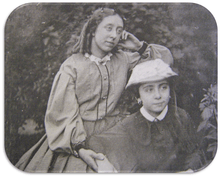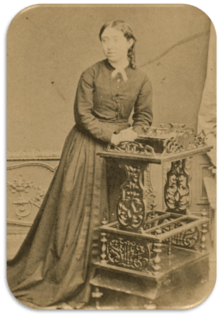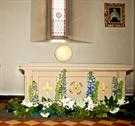Mary Potter
| Venerable Mary Potter | |
|---|---|
 Venerable Mary Potter | |
| Born |
Mary Potter November 22, 1847 |
| Died |
April 9, 1913 (aged 65) Rome, Italy |
| Nationality | English |
| Occupation | Founder Little Company of Mary Sisters |
| Religion | Roman Catholic |
| Parent(s) | William and Mary Anne (Martin) Potter |
| Website | |
|
lcmsisters | |
Mother Mary Potter (22 November 1847 – 9 April 1913) founded the Little Company of Mary in 1877. On 8 February 1988, Pope John Paul II proclaimed her Venerable.
Early life


Mary Potter was born in a rented house at 23 Old Jamaica Road in Bermondsey, South London. Mary was the fifth child and the only girl born to William and Mary Anne (Martin) Potter. Mary had a congenital heart and lung disease which left her with frail health and a permanent cough for the rest of her life. Her father left the family home in 1848, went to Australia, and never returned, leaving Mrs. Potter to raise the children by herself. When Mary was 19, she was introduced to her brother’s friend, Godfrey King and became engaged to him. After being engaged for only four months, Mary wrote to Godfrey to terminate the engagement. She was guided in this decision by Bishop Grant, who suggested she seek her calling as a religious sister.
Mary understood then that God had plans for her future and she was open to advice. Mary wrote in her reflections that as she was delicate, her mother suggested that Brighton would be a healthy place for her to go, and so they went to seek advice about her vocation at the Sisters of Mercy Convent.
Sisterhood
Mary resolved to go to Brighton by train and investigate life as a religious, with her mother and her brother. They arrived on December 7, 1868, and met the sisters. After some discussion the sisters suggested to Mary that the next day, the Feast of the Immaculate Conception, would be a good day to receive her as a postulant. This was a hasty decision and Mary was ill-prepared to enter into religious life with such immediacy. Mary decided to stay, but it must have been difficult to say goodbye for both mother and daughter after such a quick decision. Mary was willing to start in the religious life though, as she felt God was calling her to give herself to him.
Over a period of time, it became evident that life was too demanding physically for Mary and she was advised to leave the convent before her First Profession. Her spiritual director, Fr. Lambert, S.J. who seemed to understand Mary well, was convinced that she should go into a contemplative order that combined Eucharistic adoration and apostolic activity, rather than a strictly contemplative order such as the Carmelites.
He wanted her to apply to such an Order when she recovered her health.
When her mother and brother arrived to pick her up on June 23, 1870, Mrs. Potter passionately told all those gathered that she would not permit Mary to leave home ever again! This outburst and her treatment of Mary shocked the sisters.
Her mother tried to give Mary everything she felt she needed in terms of concern and love, but in fact she smothered Mary with too much kindness. This must have been frustrating for Mary after the independence she had enjoyed in the convent.
As she became stronger, Mary’s prayer life became more intense, and she was given insight into what God was asking of her, even though she felt desolate and had no spiritual support. After a period of time in which she spent much time in prayer and reflection before a crucifix, she started to think of the possibility of founding a group of religious Sisters dedicated to the spiritual, and where possible, the physical assistance of those who were sick and dying. In 1872, she became more and more convinced that this is what God was asking her to do. She wrote in her Autobiographical Notes,
"When I was praying there was a Presence – I saw nothing and yet Our Lord Crucified seemed present for a few instants."—Mary Potter
Mary sought spiritual help, and when a Monsignor John Virtue arrived in Southsea as a Military Chaplain, Mary asked him to guide her in her prayer.
She wrote many letters to Monsignor John Virtue. In these letters a unique insight was provided in the spiritual journey of Mary and the journey of the birthing of the vision she had for the Little Company of Mary. He eventually sent the letters to Cardinal Simeoni at Propaganda fide Archives in Rome where they are today. The Little Company of Mary sisters now have copies of all the letters. Mary knew these letters were important and she later wrote to Fr. Selley that they
"Show so clearly that this matter is God’s work, not mine."—Mary Potter
Little Company of Mary
Mary wrote to Monsignor Virtue about her awareness of the need to pray for the dying.
"I cannot but feel I have had a call from God to devote myself to help save souls in their last hour…..
I have been drawn so strongly to pray for the dying and I believe it to be a work appointed for me, perpetual prayer for the dying."
—Mary Potter
Mary continued to write to Monsignor Virtue knowing that each time she suggested something he would pour cold water over it. In her last letter to him she wrote
"If you ever wish to make up for what you did not of course intend, but which nevertheless, without exaggeration, you broke my heart,
when what you said to me made me think and feel almost as though I was already in hell……[and],
if ever you have to say such things to anyone else, mollify it, encourage them at the same time, for it is dangerous."—Mary Potter
In January 1876 Mary terminated the relationship with Monsignor Virtue and continued to explain to him just how much pain his counsel has caused her. Because of the mature confidence she received through these sufferings, Mary understood the great graces given to her. She later handed onto her sisters this understanding through her writings and her personal example. By this time, Mary’s brothers realized that she was in fact not a fanatic, but close to God. Mary’s youngest brother, George, now a teacher at Radcliff College, wrote to Mary suggesting that she apply to Bishop Bagshawe, (Bishop of Nottingham) for permission to work in his diocese. Bishop Bagshawe offered to pay the rent for 12 months and Mary found an old disused stocking factory for the beginnings of her “special work.”
The date of the opening ceremony of her first convent was Easter Monday, April 2, 1877. She was soon joined by other young women in this poor area called Hyson Green. After a lot of discussion with Fr. Selley and others, it was decided to call the group the Little Company of Mary. Eventually they settled on a simple dress of a plain habit of black and a pale blue veil. The Little Company of Mary sisters went out and helped the sick and poor in their homes.
Bishop Bagshawe did not agree with Mary Potter’s vision of the Little Company of Mary and could not understand that she wanted the sisters to be both ‘active and contemplative.’
He could also not understand Mary’s inspiration for the sisters to be in constant prayer for the dying.
Even through terrible trials, Mary took the opportunity to write. She was a talented writer and wrote many books, unpublished conferences and letters. During this time when Bishop Bagshawe was not allowing Mary to speak to the Novices or the sisters, she wrote a book on the Spirit and Charism of the Little Company of Mary and it was to prove invaluable to the Order. This book is called, Mary’s Conferences to her Loving Children both in the world and in the Cloister and was published in 1878.
Mary, as we know was never in good health, but in 1878 she began to feel great pain in one of her breasts. Nothing was done then, but toward the end of the year, the local doctor diagnosed a malignant breast tumour and ordered an immediate Mastectomy. The operation was performed on the kitchen table of the convent on December 8. Six months later, a similar operation was performed on her other breast. During those surgeries, very little anesthetic was used because of her heart condition. All of those present were greatly impressed by Mother’s sweetness and tranquility under these painful conditions.
Through contacts of many Bishops and Laity, the Little Company of Mary was becoming well known. There were invitations to go to other countries as the ministry the sisters' were doing was appreciated. Mary Potter was cautious and did not get caught up spreading the group too thinly. Then in 1885 five sisters prepared to sail to Sydney, Australia. The Little Company of Mary then spread to the Southern Hemisphere and flourished, attending the sick, the poor and the dying where they were needed. In Rome, Mary saw the need to build a hospital for the many patients that needed care. This was a mammoth task and a risky one, especially in a foreign country. After many years of struggling and arguing with builders and architects, Mary at last saw the completion of a “crucifix” shaped building not far from St. John Lateran, in Via S Stefano Rotondo, called the Calvary Hospital. It was there in 1908 that the first Catholic Training School for nurses commenced in Italy.
Death and funeral

As we began with the story of her death and remembering her oft-repeated words:
"The day that I can no longer receive Our Lord in Holy Communion, Our Lord Himself will come to take me."—Mary Potter
We end the story as Mary begins the journey of dying. Mary Potter uttered a cry and then peacefully died at 6:15 p.m. on Wednesday, April 9, 1913. In 1988 Pope John Paul II declared Mother Mary Potter ‘Venerable’, the first step to canonization. What she accomplished in her life, particularly in the light of her frailty, physical pain and terrible opposition from people, even those closest to her, is in fact a miracle in itself. Her inspirational example of calmness and peace in the light of these sufferings is something only those who reflect carefully would understand. In 1997 her body was returned to England and she now rests in the Cathedral of St. Barnabas, Nottingham. In summary – Mary Potter was born in 1847 and grew up in a single-parent family. She endured a life of suffering from ill health and misunderstanding from those who opposed her, yet her vision lives on in the work of her congregation, helping many in the last and most difficult moments of their life. The Little Company of Mary is an international religious congregation whose main ministry is to pray for and assist the sick and dying throughout the world.
She has a Nottingham Tram named after her, after she was nominated in a BBC poll. In addition one of the conference rooms in the Newton building of Nottingham Trent University was named in honour of her after its refurbishment in January 2010.
See also
References
- Elizabeth West, ‘Potter, Mary Cecilia (1847–1913)’, Oxford Dictionary of National Biography, Oxford University Press, 2004
- Patrick Dougherty, Mother Mary Potter: Foundress of the Little Company of Mary (1847-1913), Little Company of Mary Mother House, 1961
- Sr. Elizabeth Gilroy, LCM, Mary Potter CTS Saints of the Isles,CTS Publishers London, 2010
External links
- About Ven. Mother Mary Potter and Devotion For The Dying biography from catholictradition.org
- Little Company of Mary Sisters | Her Story
|